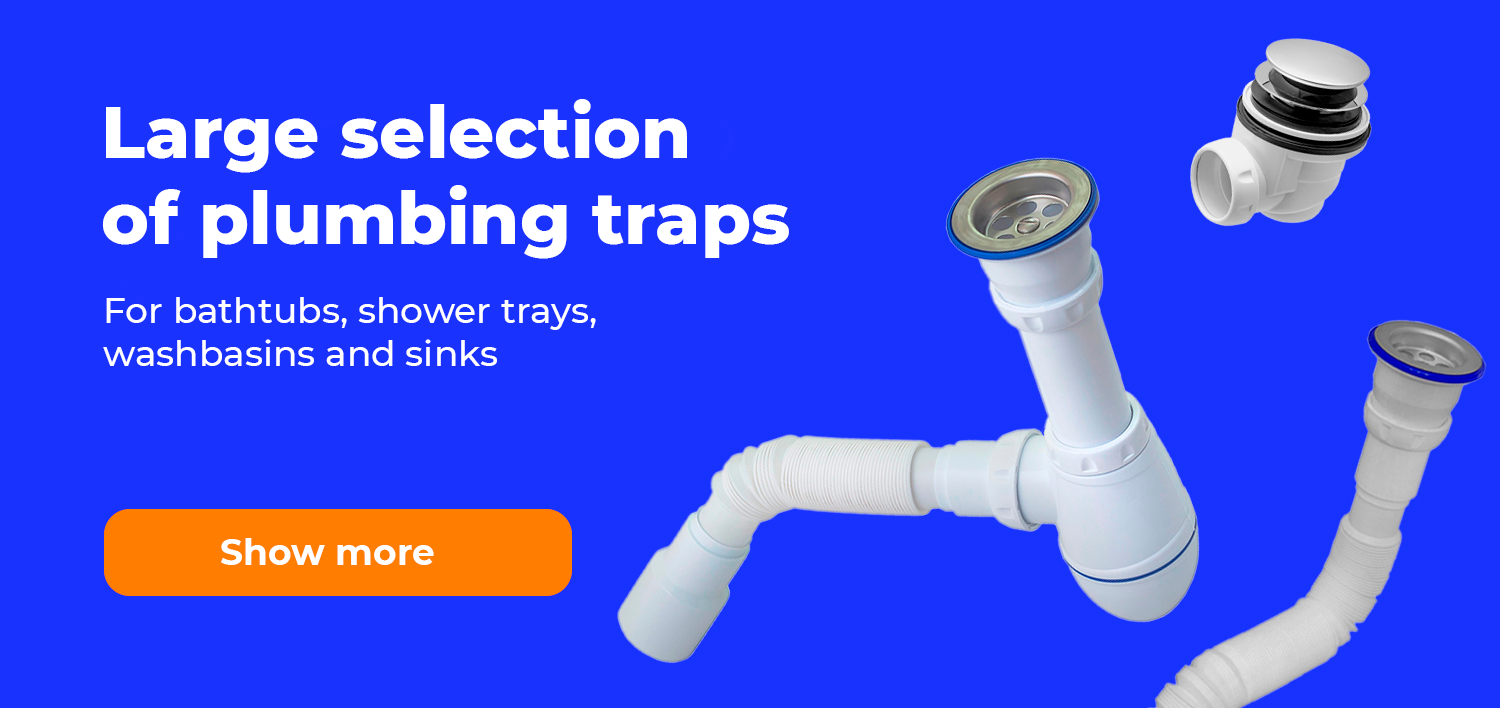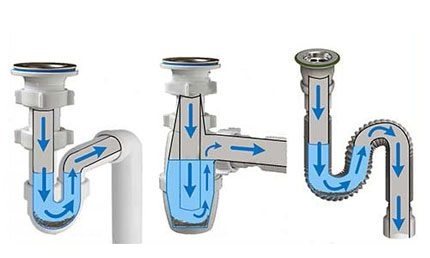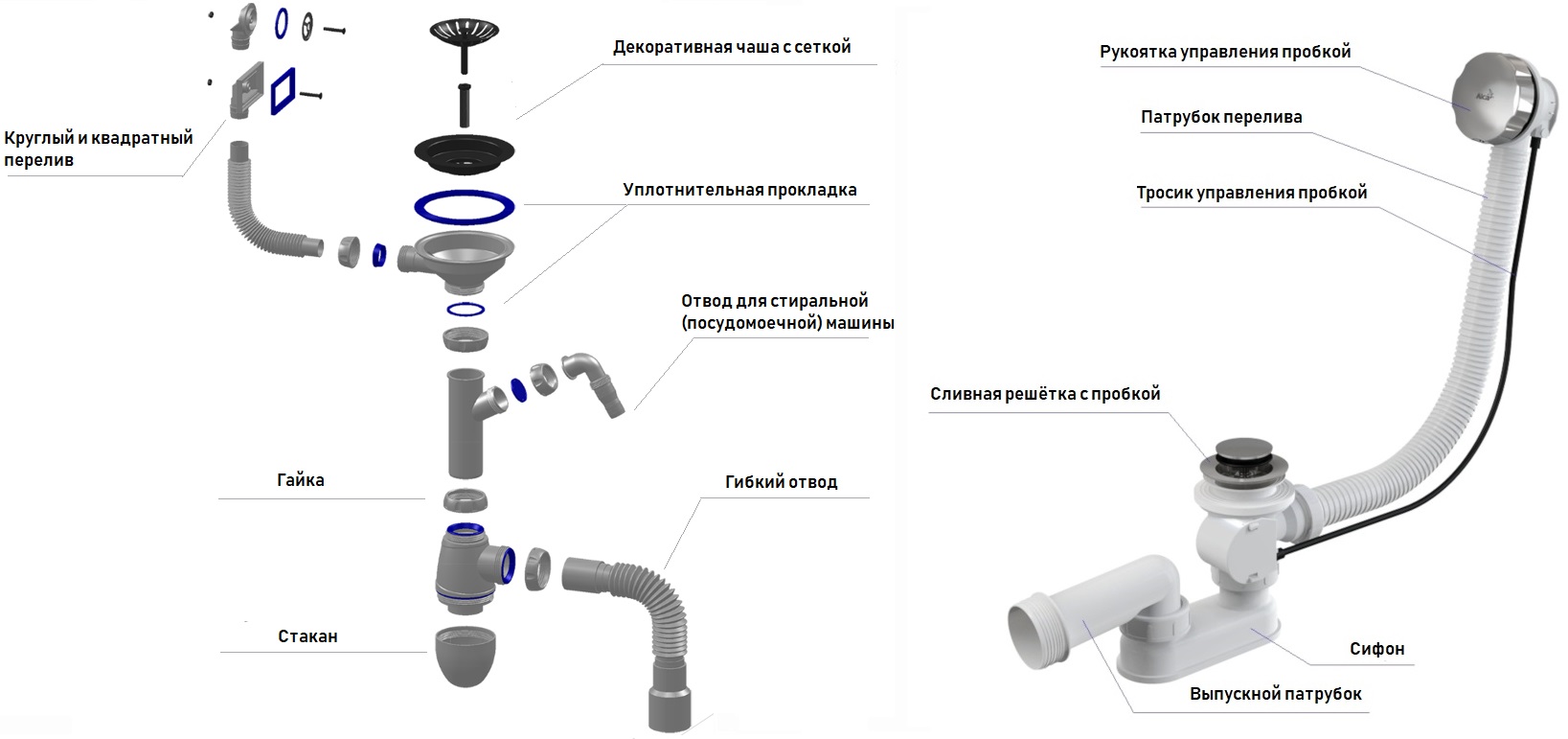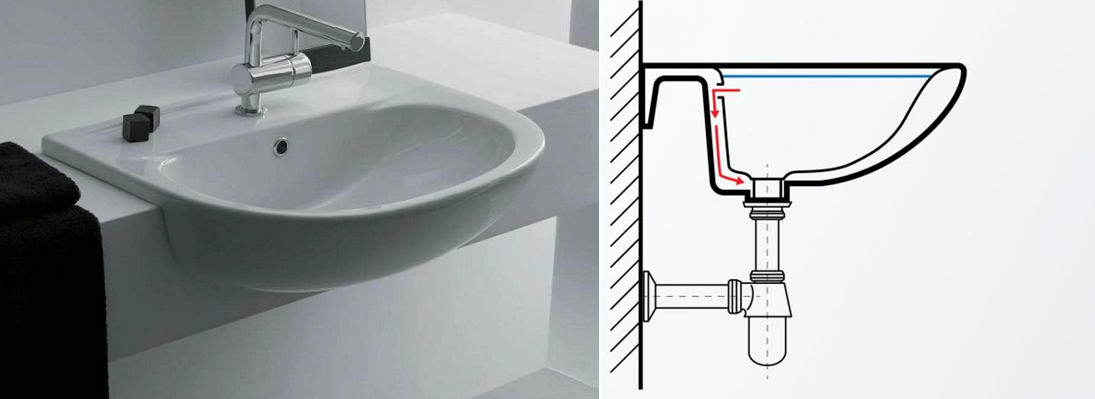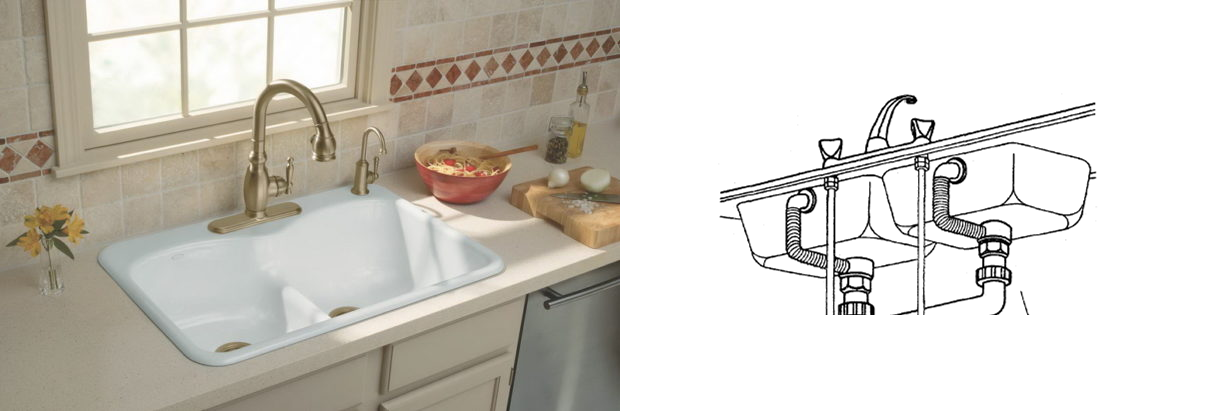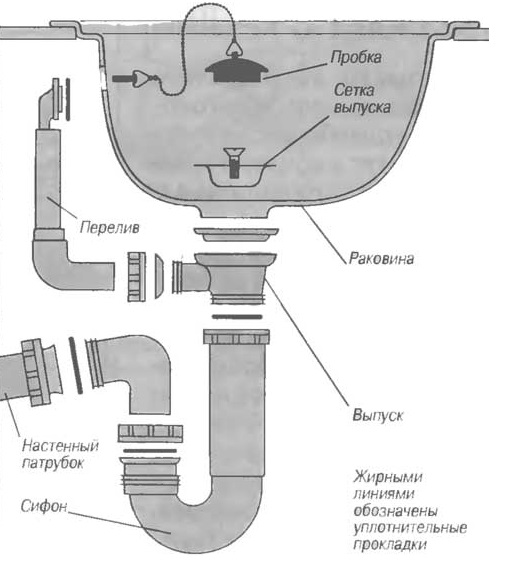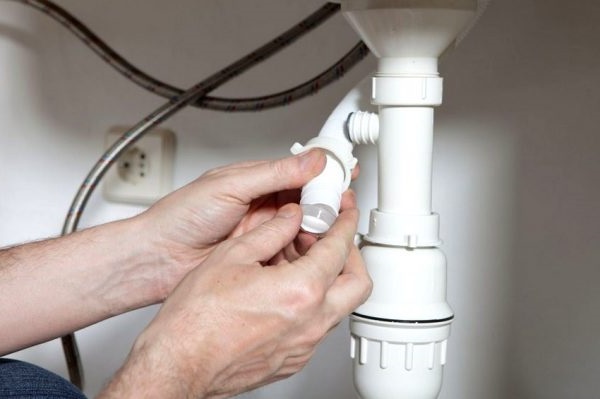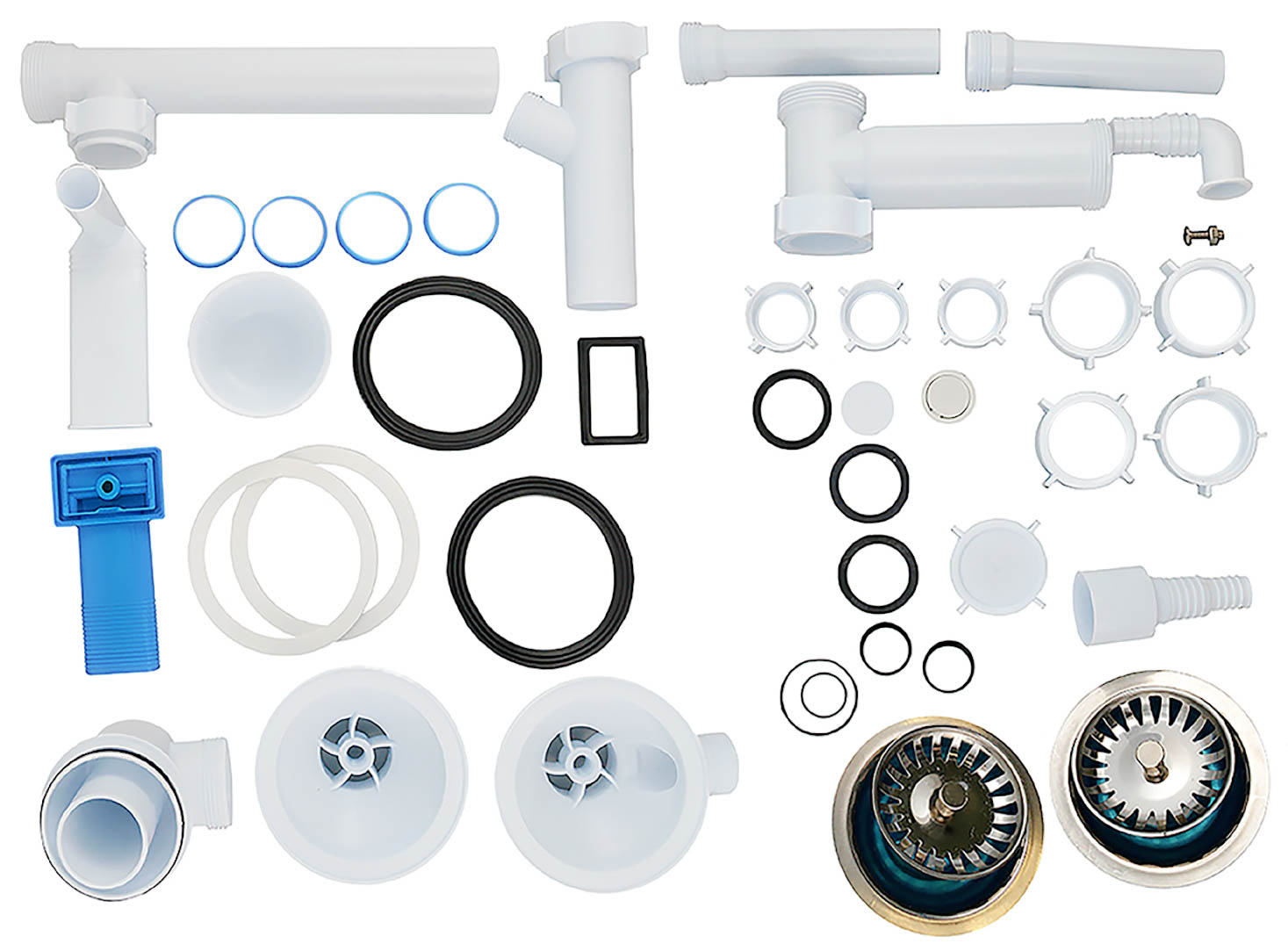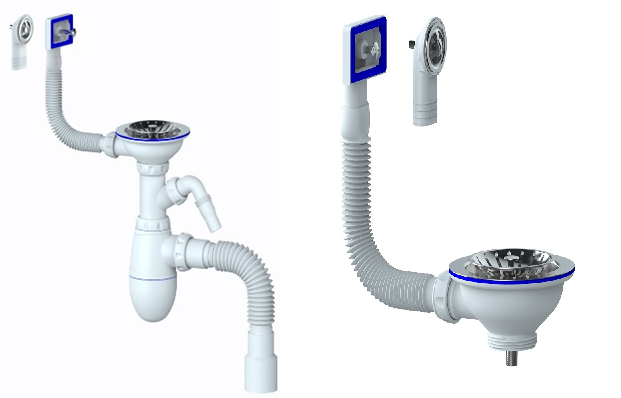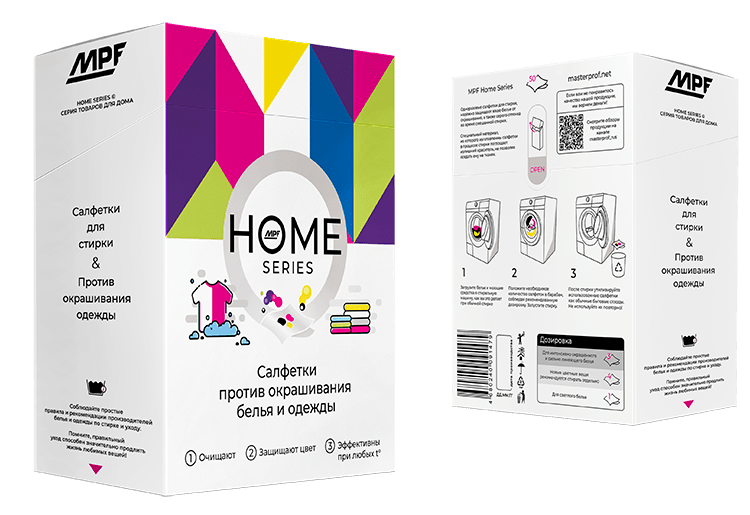Plumbing trap is the main element of the plumbing connection, designed to drain water into the stack. Furthermore, the trap provides protection against clogging, and also acts as a barrier preventing sewage odors from entering the room. This article describes all types of traps, contains tips on how to choose, assemble and replace them.
What is a trap
A trap is a special device consisting of one or more pipes and reservoirs, designed to connect plumbing fixtures to wastewater disposal systems. Thanks to its structure and bends, it creates an air-tight plug between the sewer and the room, preventing odors and bacteria from entering into the room.
Traps are used in a variety of rooms, including kitchen, bathroom, shower cubicle. They differ from each other in structure, material and drain overlap, as well as in size. Despite the differences, all types have a similar structure of the main parts, including:
- Body;
- Branch pipes;
- Waste;
- Bends;
- Connecting nuts and screws;
- Gaskets for air-tightness.
How to choose a trap
A trap manufacturer uses several terms referred to the sink:
- Washbasin, another name for a sink, is a bowl-shaped arrangement designed for washing hands;
- Tulip is the name of a sink with a semi-porcelain floor stand;
- Kitchen sink is the most frequent name for a pot sink. These have larger waste. It is assumed that quite large food waste particles can get from the kitchen sink to the drain. Alternatively, a consumer may want to install a garbage disposal.
For a general understanding, we are going to combine all these names into a single one, a sink.
To make a decision to buy a trap, you need to know:
- What is a sink waste diameter;
- Is there an additional hole in the sink for overflow protection;
- Is the overflow round or square;
- Do I need an additional hole to connect a washing machine or a dishwasher;
- What is the diameter of the sewer pipe for connecting the trap.
Having answered these questions, you can easily find the right trap for your sink. Let's move one by one.
Diameter of a drain hole
You can compare the diameter of the drain hole with the trap according to the table:
An overflow is a hole in the upper part of the sink, which protects the owner from flooding if he or she left the water turned on and closed the drain hole. It may be built into the sink. For instance, in porcelain sinks, the overflow hole is connected to the drain hole directly in the porcelain mixture by a special channel.
Fig 1. Sink with embedded overflow
Fig 2. Sink with overflow
Form of an overflow hole
The overflow holes are of two types, square and round. You just need to look at the shape of the hole on the sink and choose a trap with the same overflow shape.
Some manufacturers (e.g., Unicorn) supply traps already with two types of overflow (Fig. 3). Therefore, one is installed, the second heads binwards.
Fig 3. Square and round overflow in one set
A hole for connecting a washing machine or a dishwasher
This is a simple question. The machine either needs to be connected to a trap, or not. All manufacturers specify what additional holes they have. If you need to connect both a washing machine and a dishwasher, then there are traps with two beaks for connecting them.
If you bought a trap with a hole for connecting a washing machine or a dishwasher, but you did not need it, then don’t worry. You can safely use the trap without connecting the holes. The beak for connecting the machine is designed specifically to avoid leaks. Some manufacturers include plugs for extra holes in the set.
Diameter of a drain pipe
Here, everything is simple, too. In Russia, pipes with a diameter of 40mm or 50mm are most often used to connect sinks. Therefore, there is a designation of the connection diameter at the end of the trap name. If you have a 40mm pipe, you choose a trap with the designation “40”. Sometimes, trap manufacturers use the designation “40/50”. This means that the set includes a universal corrugated pipe with a connection diameter of 40 or 50 mm. In case you need a 50mm connection, you simply insert the end of the corrugated pipe into the drain pipe. If you have a drain hole with a diameter of 40 mm, you simply cut off the end of the corrugated pipe (diameter 50 mm) just below the step, and you get a pipe with a diameter of 40 mm.
In European countries and less often in Russia, you can also find a pipe with a 32 mm connection. Most often, such a connection diameter is for the traps with a waste size of 1 ¼. These parameters are also indicated by any manufacturer in the name of the trap.
The location of the drain pipe to which the trap is connected is also worth mentioning. After all, it can go out both from the walls and from the floor. In case of using a flexible corrugated pipe, this does not really matter. Connection is possible from any location. However, if you are a supporter of rigid pipe connections, then it is important for you to pay attention to location when choosing a trap, and to choose the one with the required connection.
There is also a slight nuance as for the length of the screw used in the trap. Some manufacturers write screw parameters, and some do not. The screw in the trap connects (or rather, tightens) the upper cup with the mesh, located in the sink drain, with the lower part of the trap. There are two types of screws: plastic (economy version) and metal (standard version). Metal screws come in different lengths, from 40mm to 80mm. The length of the screw is worth paying attention to if you have a very large distance between the sink drain and its bottom, or, in other words, a large height of the sink drain hole.
Now you can easily understand what 1 1/2” *40 designation in a trap name means (a trap with a drain hole of 1 ½ and with a 40mm connection to the drain pipe) or 1 1/4" *32 with a flexible pipe 32*32/40 (a trap with a drain hole of 1 ¼ with 32 or 40 mm connection to the drain pipe).
To make the selection of Unicorn traps easier, we have prepared a table for you:
Sink trap dimensions
There are the following waste sizes for sink traps:
- Stainless steel waste for sinks <1.1/4";
- Stainless steel waste for sinks 1.1/2" Unicorn;
- E150P waste 3.1/2" (stainless steel cup 112 mm in diameter) Unicorn;
- E157 waste 3.1/2" (stainless steel cup 112 mm in diameter, round and rectangular overflow) Unicorn;
- Click-clack waste for washbasin 1.1/4" with overflow (round);
- Click-clack waste for washbasin 1.1/4" with overflow hole (square).
But how do you choose the right one? You may notice there are different waste sizes: 1 ½, 3 ½ and 1 ¼. The 1 ½ diameter size is most often found in small kitchen sinks, in the bathroom, on older models and in the extra bowl of 1.5 bowl sinks. The diameter of the sink or bath waste for this trap should be about 42-48 mm. There is no unified standard, but since the trap is connected to the sink waste by pressing the trap through the gasket on both sides, the waste diameter may be different.
The current European standard for kitchen sink drain hole is 3 ½ (approximate diameter of 90-92mm). The sinks with the said diameter are installed in the kitchen and, due to the size of the holes, they allow water to drain faster, and also, in comparison with other sinks, are less likely to clog up with food residues. The hole size has also been increased in case you want to install a garbage disposal in your kitchen sink.
Based on the above, we can conclude: if you are looking for a trap for a bathroom sink, and the diameter of the hole for the drain you have is 42-48mm, then a trap with a size of 1 ½ is suitable for you. If you are installing a sink in the kitchen and you have a hole diameter in the sink of 90-92mm, then take a trap with a diameter of 3 ½.
What is the difference between the kitchen sink and washbasin traps
Washbasin trap 1 ½ has a capacity of 40 liters per minute, and has a standard waste size 1 1/2, screw 6*80. The 80 mm screw length is due to the fact that the depth of the hole in a porcelain or semi-porcelain sink can be quite large due to the thickness of the material or the overflow embedded into the sink. The screw length of 80 mm is enough to pull together parts of the trap on a sink of any thickness.
In this case, the waste can be either split or cast. The cast waste is characterized by a smaller number of connections, it is less prone to leaks, it is cheaper than a split one, but makes it difficult to disassemble the unit.
The waste can be corrugated and in the form of a pipe, while there are options with a side outlet for a washing machine or a dishwasher.
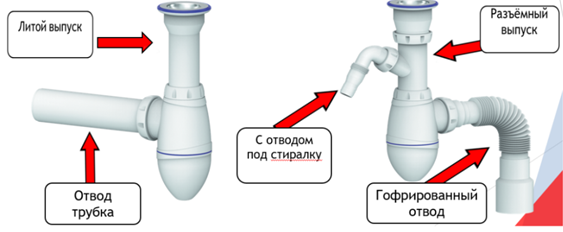
Kitchen sink trap 1 ½ almost does not differ from the trap for the washbasin structurally, except that the cup has a more rounded shape. The water coming from the kitchen sink into the trap is more prone to contamination than in the washbasin, therefore the manufacturers make the cup (or bottle) of the trap a little larger. For instance: a slight increase in the cup of the Unicorn traps for kitchen sinks increases the throughput by 6-8 liters per minute.
The screw 6*40 has been reduced for this trap. If you use a 6*80 screw, this will lead to winding up excess debris and clogging the trap. A 40 mm screw is enough to connect the trap parts on any stainless steel sink.
Drain-overflow system has waste sizes 1 1/2 as well as 3 ½. The system can have two cups for two sinks at once, and has a capacity of 50 liters per minute. If the kitchen sink is equipped with a second upper drain, a trap is installed from below, equipped with an additional (overflow) pipe. This helps to avoid accidental flooding.
The system has round and square overflow. The round one is used for ceramic (stone) sinks, and the square one is used for stainless steel sinks (the mesh is not needed for this overflow, since the mesh is provided in the structure itself).

Types of traps
There are several types of traps, which differ in external and design features, as well as in the material of manufacture of the item. Let's consider the most popular types:
- Corrugated;
- Pipe;
- Bottle;
- Flat;
- Bath trap;
- Semi-automatic;
- Automatic.
Corrugated trap
Advantages:
-
Easy to install, affordable price;
-
Doesn't require a lot of space;
-
Practically eliminates leaks due to its simplicity;
-
Can be connected to a sink even in a non-standard position.
Disadvantages:
-
Dirt quickly forms due to unevenness;
-
A complete dismantling is required for cleaning;
-
Hot water has a negative effect on the corrugated pipe.
-
It does not have appealing look, since all the accumulated dirt begins to shine through.
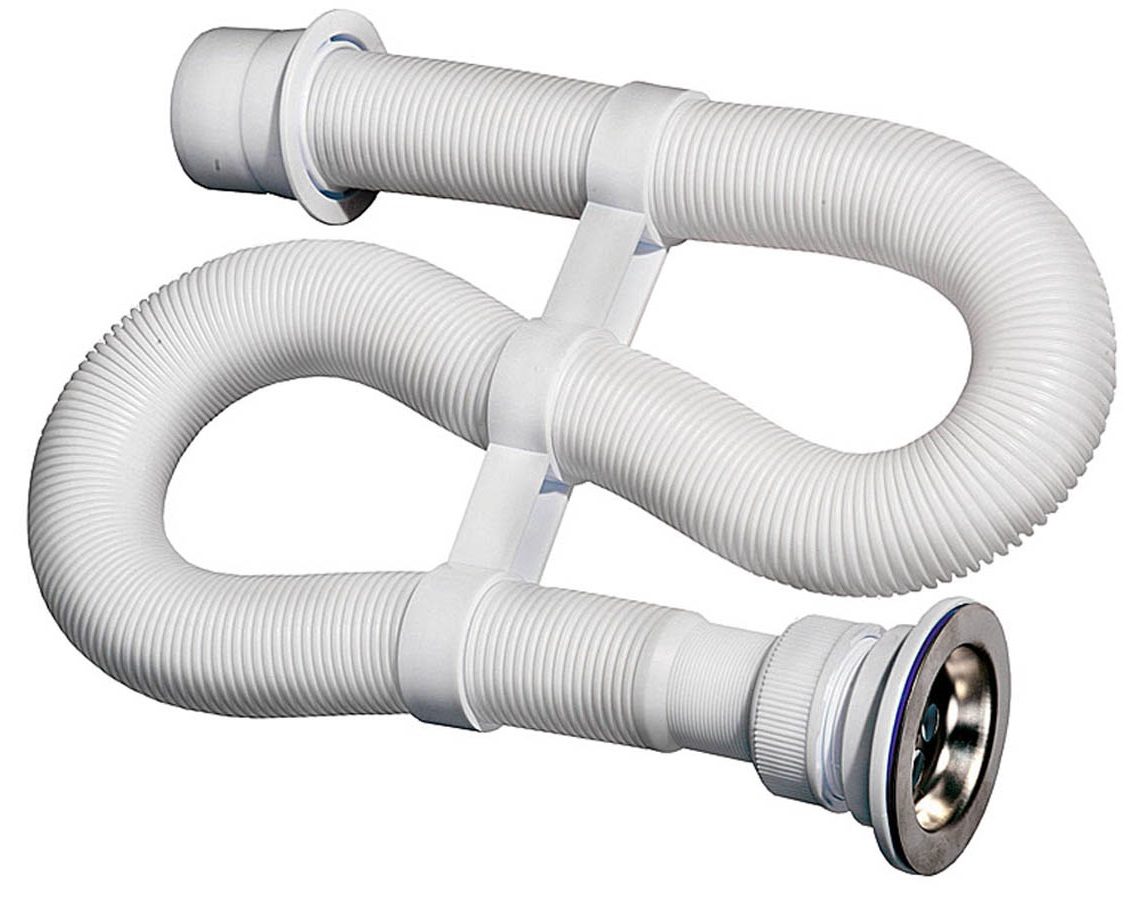
Pipe trap
Such traps are the often installed in bathrooms, ceramic sinks and bathrooms. They are great for bathrooms, but not recommended for use in the kitchen since they are difficult to clean compared to other types.
The trap looks quite appealing, and has the shape of a curved S-pipe where water constantly accumulates and acts as a water seal. It is worth mentioning that the capacity of such traps is quite small, which is why, if you do not use the sink and bathtub for a long time, the water that forms a water seal quickly evaporates. Therefore, you can notice an unpleasant sewer smell after a long absence.
Advantages:
-
Long service life when used correctly;
-
Appealing look.
Disadvantages:
-
Shallow water seal;
-
Rigid construction requires precise sizing;
-
The middle tube needs to be dismantled with a twist for cleaning.
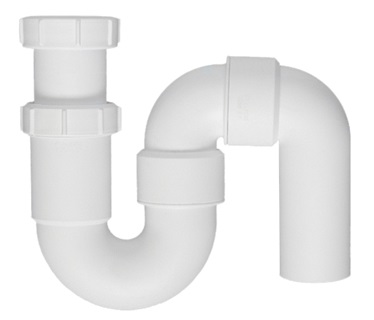
Bottle trap
This is one of the most popular traps, with a bottle-like shape. It became popular due to the fact that, thanks to its design features, after purchasing a trap, the buyer has the opportunity to adjust the gap between the waste neck and the sewer socket. This type is convenient for assembly and disassembly, therefore, if necessary, cleaning will not cause any problems.
Advantages:
-
Easy to maintain;
-
Bottle drain does not require replacement for a long time;
-
There is always water in a water seal;
-
If a small thing fell into the drain, then it is easy to collect it by unscrewing the bottle.
Disadvantages:
- Possibility of leakage due to a loose connection of a large number of connections.
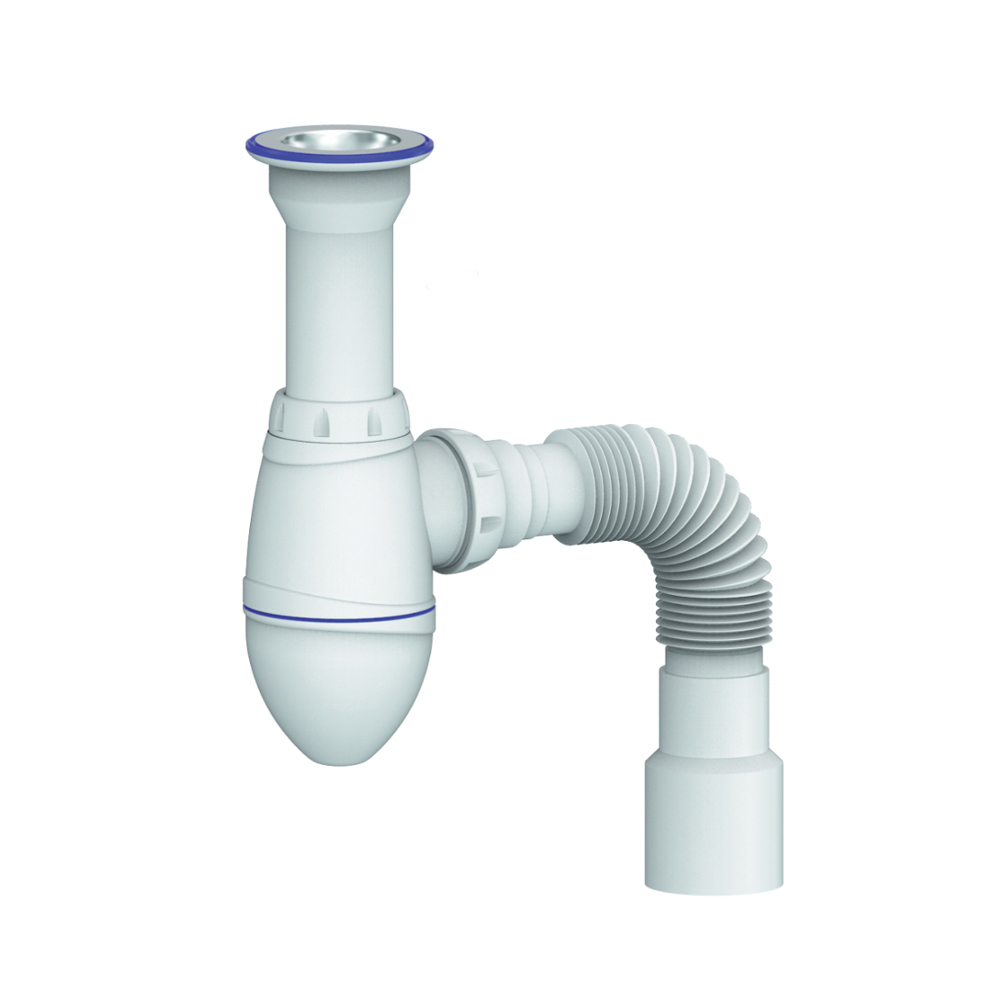
Flat trap
Such models can be referred to as a type of bottle traps, since their main difference lies only in the compact size and flat shape of the bottle. Most often they are used when there is not enough space to install the bottle version. For instance, below a bath or a shower cabin.
The disadvantages include the reduced water throughput due to the compact dimensions of the trap.
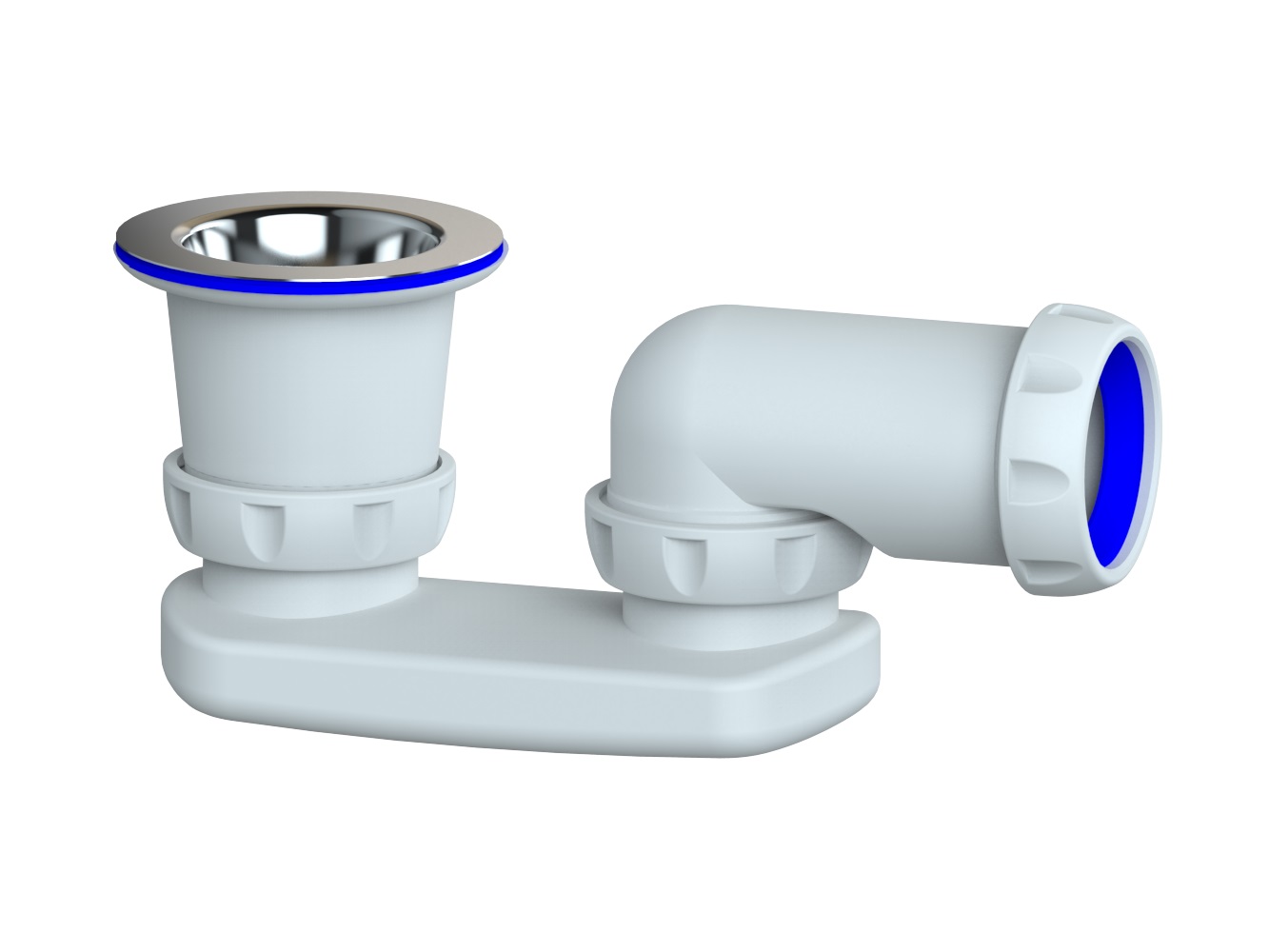
Bath trap
The classic bath trap is an excellent option for bathtubs with overflow. Its complete set includes plugs, which are made of various materials such as plastic, rubber and even metal.
Advantages:
-
Low cost;
-
Simple installation;
-
Durability.
Disadvantages:
- Manual opening/closing of the waste.
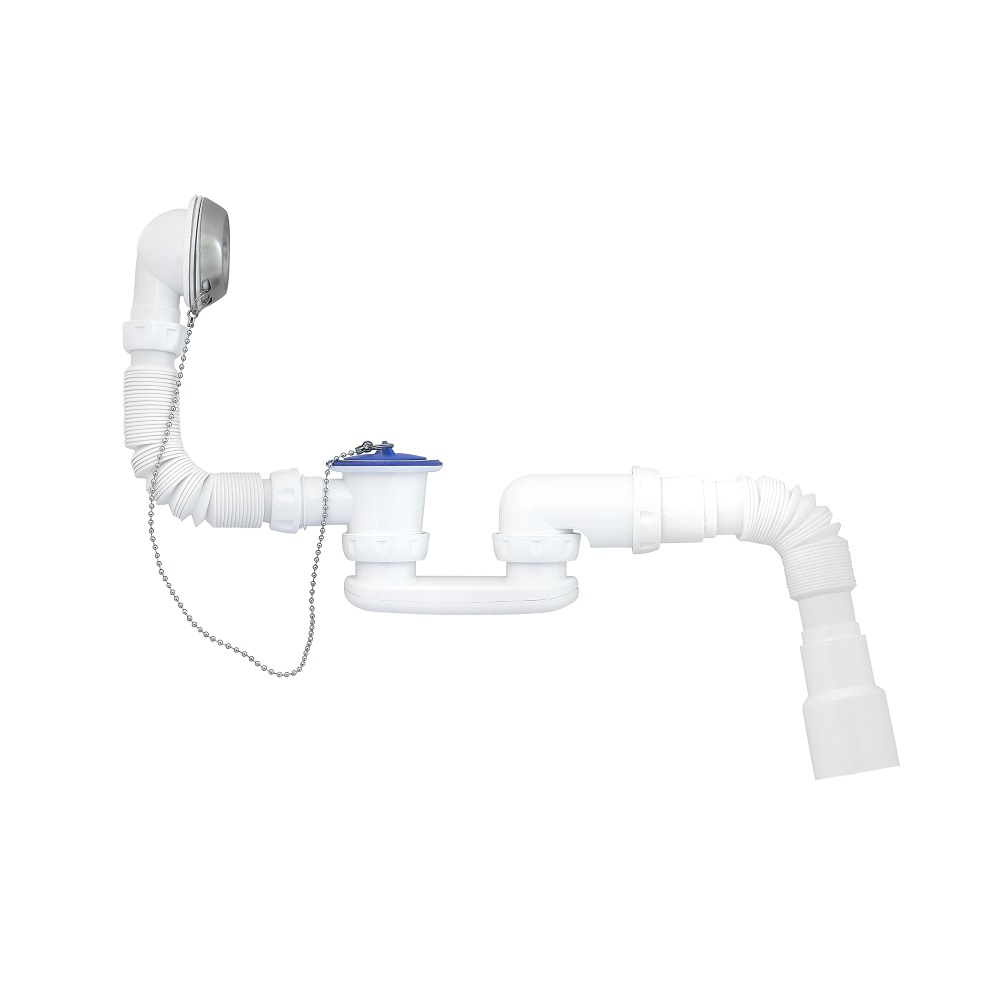
Semi-automatic
Further development of the bath trap led to the fact that it became semi-automatic by installing a plug drive installed in the waste in the area of the overflow cover.
Such a system is the simplest in terms of operation, and does not require additional levers and plugs.
Advantages:
-
Convenient operation;
-
Reliability when buying a quality trap;
-
No need to get your hands wet to open the waste.
Disadvantages:
-
High cost;
-
When buying a budget version, there is a high probability of failure of mechanisms;
-
If the cable fails, the entire structure will need to be changed.
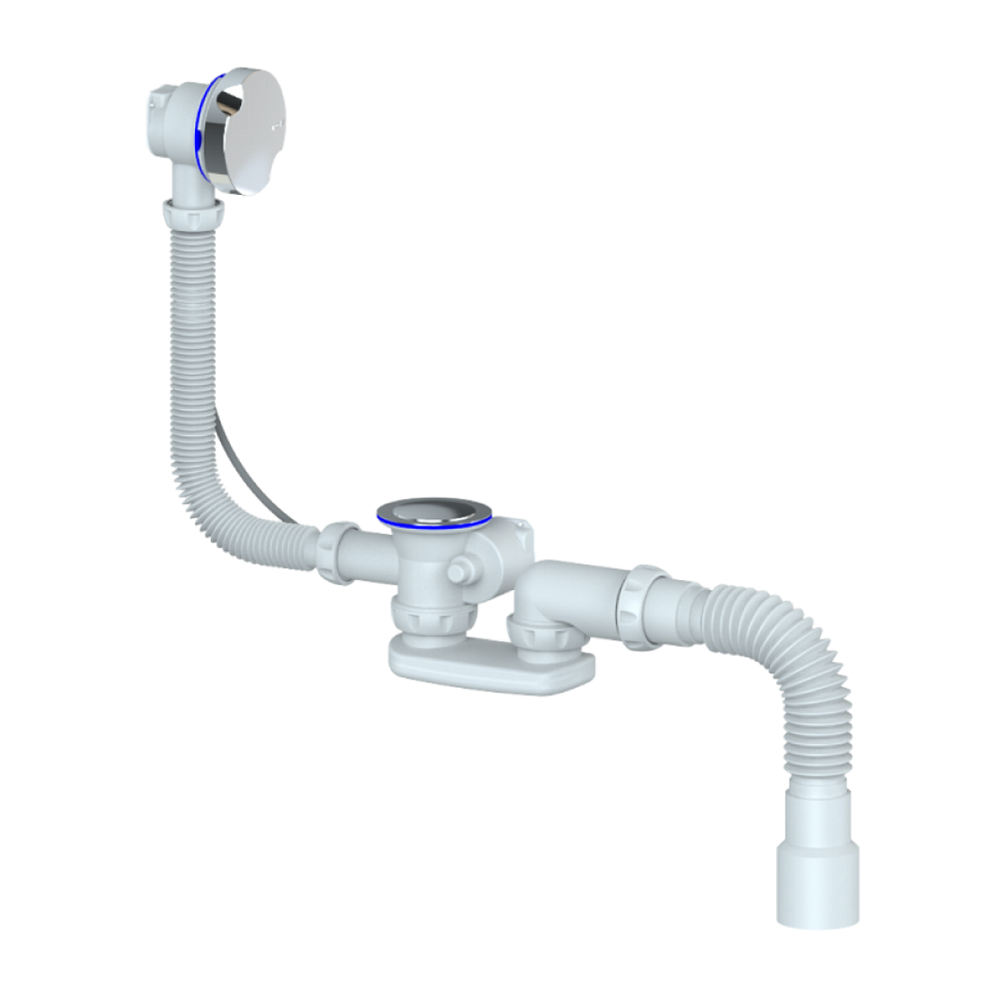
Click-clack trap
The bath trap was further developed after it was equipped with a click-clack system, which improved its consumer properties. Now, to open/close the waste, you just need to press the button.
Advantages:
-
Convenient operation;
-
Appealing look;
-
Compactness;
-
Touch the cover with your hand/foot to open/close the waste;
-
The overflow is covered with a chrome-plated element.
Disadvantages:
-
High cost;
-
Low reliability of the shut-off valve and spring;
- Difficult to repair.
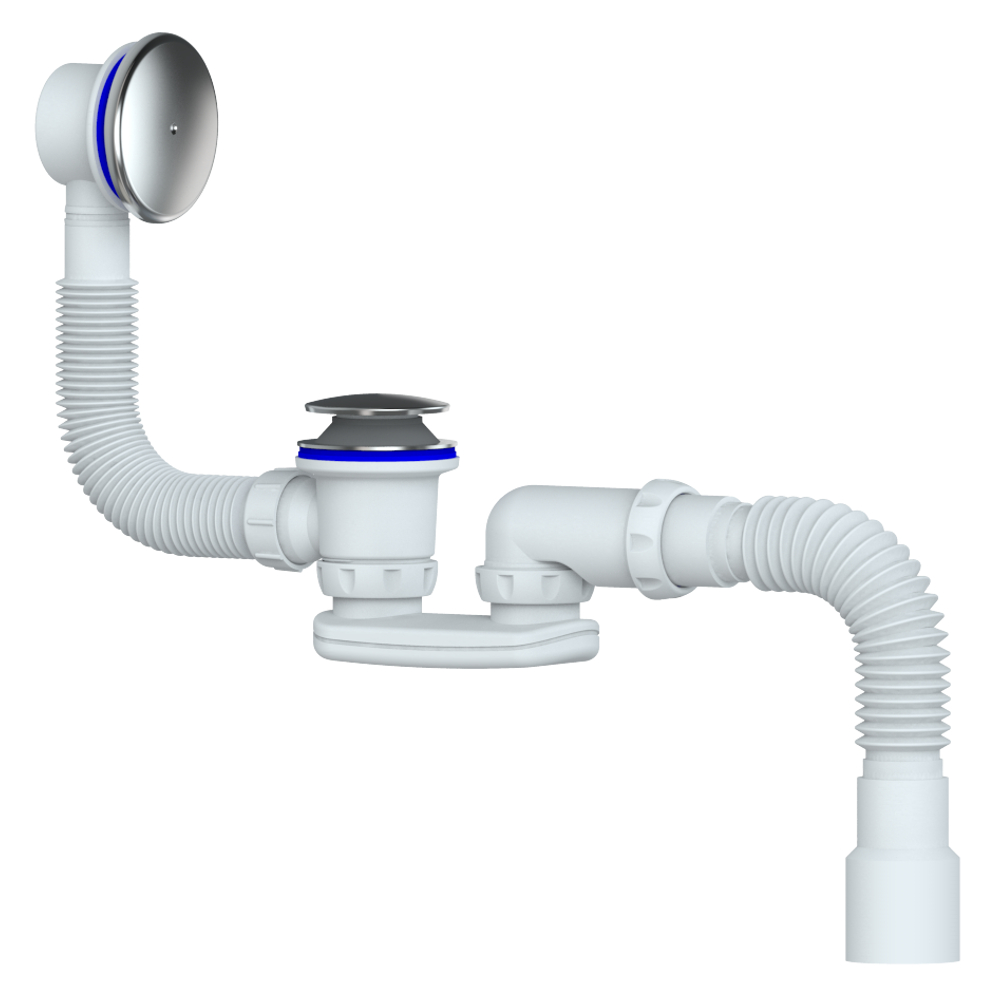
How to assemble a sink trap
Replacing an old trap is not a problem even for people who are far from plumbing. The main thing is to follow the sequence of actions and follow the specialists’ recommendations.
Remove the old trap
You will need a minimal set of tools, or rather a large screwdriver. Before work, place a basin or other container under the trap, since after removing the bottle, water may pour out.
Holding the bottle underneath, start unscrewing the screw located in the center of the waste mesh in the sink with a screwdriver. After successfully completing the task, it is enough to disconnect the drain pipe from the sewer. You did it, now the trap is removed.
Sink trap assembly
Please, note that there is no need to use sealant and silicone grease when assembling the sink trap. The parts must fit snugly together without additional means and materials. The set should include all the accessories necessary for installing the water seal, including rubber gaskets, nuts, screw and instructions.
The assembly is carried out in six stages:
-
Lay out the parts in the order in which they should be connected according to the instructions. This need to be done in order to check the availability of parts and plan further actions.
-
In the case of installing a bottle trap, the bottle should be assembled first. To do this, you need to install the rubber gasket from the set and connect the two parts of the reservoir.
-
Before connecting to the bottle branch pipe, a plastic nut is put on the corrugated pipe, after which a cone-shaped gasket is installed on the pipe. The thin edge should be on the side of the bottle.
-
Connect the corrugated pipe and the bottle. Note that the cone-shaped gasket must ensure the tightness of the two elements.
-
Tighten the nut to make the structure more robust.
-
Slide the nut onto the neck branch pipe, and then the gasket with its tip down.
MasterProf offers its customers UNICORN branded traps. The use of the traps will help to avoid most of the difficulties during installation due to several points: the trap bottle is supplied already assembled and most of the gaskets are integrated into the trap body. You no longer need to guess which gasket is installed where.
Sink trap assembly
Install the trap neck (branch pipe) under the sink, having previously placed a gasket on its expanded top. At the same time, install another rubber gasket on the drain hole, then fix the metal mesh, and screw in the metal screw.
IMPORTANT: A PLASTIC NUT IS PUT ON THE LOWER SECTION OF THE NECK, THEN A GASKET IS INSTALLED. THE THINNER EDGE OF THE GASKET SHOULD BE ON THE RESERVOIR SIDE. AFTER COMPLETING THESE STEPS, YOU CAN PROCEED WITH THE INSTALLATION OF THE PREVIOUSLY ASSEMBLED UNIT OF THE WATER SEAL. FIX IT ON BOTH SIDES: CONNECT ONE END TO THE NECK AND THE OTHER TO THE SEWER PIPE.
Initially, you need to tighten the plastic nut, which is located at the top of the plumbing fixture. Please, note that in this case, the neck should be immersed into the bottle to the quite extent. Then seal the joint between the corrugated pipe and the sewer pipe. You can choose a simple rubber sleeve as a gasket, which will not allow drains to penetrate outside the pipe.
How to assemble a bathroom trap
Unfortunately, most kits are sold disassembled and you have to assemble them yourself. This is not difficult if you listen to the advice of professionals, and follow the correct order.
Before purchasing, be sure to check the integrity of the threads and make sure there is no visible damage to the connecting elements.
Assembling the classic trap
The assembly algorithm includes six stages:
- Attach the chain connected to the plug to the overflow cap.
- Approach the outlet pipe with the inserted gasket outwards to the bath drain.
- Install a protective mesh from the inside of the reservoir. Secure the assembly with a nut or copper screw without over-tightening.
- Similarly, assemble the overflow drain using a corrugated hose for attaching to the trap, with the cone-shaped rubber gaskets and coupling nuts already installed.
- Attach the removable elbow to the outlet. It acts as a water seal.
- Insert the adapter into the other end of the elbow to connect to the drain.

Features of installation of semi-automatic assembly
Installation of a semi-automatic device will require additional elements. Installation is performed as follows:
-
Initially, insert the sewer connection all the way into the drain neck. You do not need to use separate parts since the gasket is already present.
-
Place a double gasket over the opening of the overflow assembly, and then begin to mount the metal filter.
-
Take flat metal covers and attach to the control cable, then connect to the water drain hole.
-
Secure the assembly to the overflow with a bolt.
Useful tips
If you are faced with a problem when choosing or installing a trap, we have collected a number of useful tips to make the task easier:
-
We recommend making a choice in favor of smooth-walled systems, since they are easier to clean;
-
When replacing the old trap with a new one, close the socket of the sewer drain with a rag or something dense to prevent unpleasant odors from entering the apartment;
-
To eliminate the possibility of leaks, it is better to carefully seal all joints and connections;
-
We recommend to purchase a trap strictly with a branch pipe diameter matching the socket diameter.
Unicorn traps
MasterProf, being the exclusive partner of the Unicorn plant, offers a wide range of the products of this brand.
Unicorn traps are a new generation of traps on the Russian market.
Initially, when designing traps, the main focus was on the convenience of the end user. Thus, Unicorn branded traps have gained a number of unique advantages:
-
The Unicorn plant was the first in Russia to start production of traps with integrated thermoelastic plastic gaskets. Such an innovation allowed the end consumer to spend significantly less time on assembling the trap, and the stores selling these traps avoided a large number of defects associated with under-completing.
-
The 3 ½ kitchen sink traps originally were intended to be multi-purpose, and are suitable for sinks by all manufacturers. The set already includes overflows of round and rectangular shapes.
-
The trap is made of high quality virgin polypropylene. Polypropylene is a more elastic material than plastic. For comparison, many manufacturers add chalk and recycled plastic to reduce the cost.
-
All gaskets for Unicorn traps are made of thermoplastic elastomer (the material used for car panels, toothbrushes, etc.). This material is not subject to mechanical stress and does not change its characteristics when exposed to temperature. Due to the reliable gaskets, the trap can be disassembled up to 50 times, while other manufacturers use rubber or PVC gaskets. When such traps are disassembled, the gaskets quickly fail and the trap begins to leak.
-
At the time of its introduction, the Unicorn flat trap for bathtubs was the lowest trap among Russian manufacturers. This trap is suitable for bathtubs and shower trays installed at a height of at least 8.5 cm.
-
All traps are equipped with a multi-purpose corrugated pipe that provides connection to sewer pipes with a diameter of 40 or 50 mm.
-
The plant provides a 12-year warranty for its products!
Traps by wholesale
MasterProf offers to purchase traps by wholesale with the possibility of delivery throughout Russia and the CIS countries. We are a direct supplier of the manufacturer of traps and are engaged in the wholesale supply of engineering plumbing to private construction and plumbing stores, as well as to DIY hypermarkets. We offer a wide range of trap models for any need.
Over the years, we have established partnerships with many stores and suppliers. Examples of our work.
Our experts will help you organize your own business and select the suitable products.
Do you still have questions? Call or e-mail us, we will answer.
Phone: +7 812 309-53-81
E-mail: info@masterprof.spb.ru
Address: St. Petersburg, 5/1 Zastavskaya Street.

